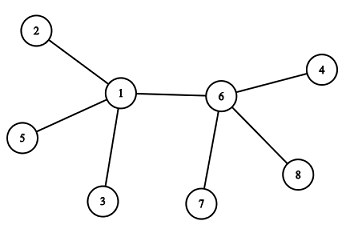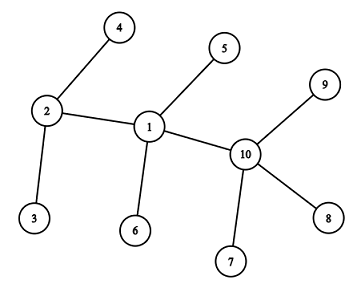Preparando MOJI
You are given a tree (connected graph without cycles) consisting of $$$n$$$ vertices. The tree is unrooted — it is just a connected undirected graph without cycles.
In one move, you can choose exactly $$$k$$$ leaves (leaf is such a vertex that is connected to only one another vertex) connected to the same vertex and remove them with edges incident to them. I.e. you choose such leaves $$$u_1, u_2, \dots, u_k$$$ that there are edges $$$(u_1, v)$$$, $$$(u_2, v)$$$, $$$\dots$$$, $$$(u_k, v)$$$ and remove these leaves and these edges.
Your task is to find the maximum number of moves you can perform if you remove leaves optimally.
You have to answer $$$t$$$ independent test cases.
The first line of the input contains one integer $$$t$$$ ($$$1 \le t \le 2 \cdot 10^4$$$) — the number of test cases. Then $$$t$$$ test cases follow.
The first line of the test case contains two integers $$$n$$$ and $$$k$$$ ($$$2 \le n \le 2 \cdot 10^5$$$; $$$1 \le k < n$$$) — the number of vertices in the tree and the number of leaves you remove in one move, respectively. The next $$$n-1$$$ lines describe edges. The $$$i$$$-th edge is represented as two integers $$$x_i$$$ and $$$y_i$$$ ($$$1 \le x_i, y_i \le n$$$), where $$$x_i$$$ and $$$y_i$$$ are vertices the $$$i$$$-th edge connects. It is guaranteed that the given set of edges forms a tree.
It is guaranteed that the sum of $$$n$$$ does not exceed $$$2 \cdot 10^5$$$ ($$$\sum n \le 2 \cdot 10^5$$$).
For each test case, print the answer — the maximum number of moves you can perform if you remove leaves optimally.
4 8 3 1 2 1 5 7 6 6 8 3 1 6 4 6 1 10 3 1 2 1 10 2 3 1 5 1 6 2 4 7 10 10 9 8 10 7 2 3 1 4 5 3 6 7 4 1 2 1 4 5 1 1 2 2 3 4 3 5 3
2 3 3 4
The picture corresponding to the first test case of the example:

There you can remove vertices $$$2$$$, $$$5$$$ and $$$3$$$ during the first move and vertices $$$1$$$, $$$7$$$ and $$$4$$$ during the second move.
The picture corresponding to the second test case of the example:

There you can remove vertices $$$7$$$, $$$8$$$ and $$$9$$$ during the first move, then vertices $$$5$$$, $$$6$$$ and $$$10$$$ during the second move and vertices $$$1$$$, $$$3$$$ and $$$4$$$ during the third move.
The picture corresponding to the third test case of the example:

There you can remove vertices $$$5$$$ and $$$7$$$ during the first move, then vertices $$$2$$$ and $$$4$$$ during the second move and vertices $$$1$$$ and $$$6$$$ during the third move.